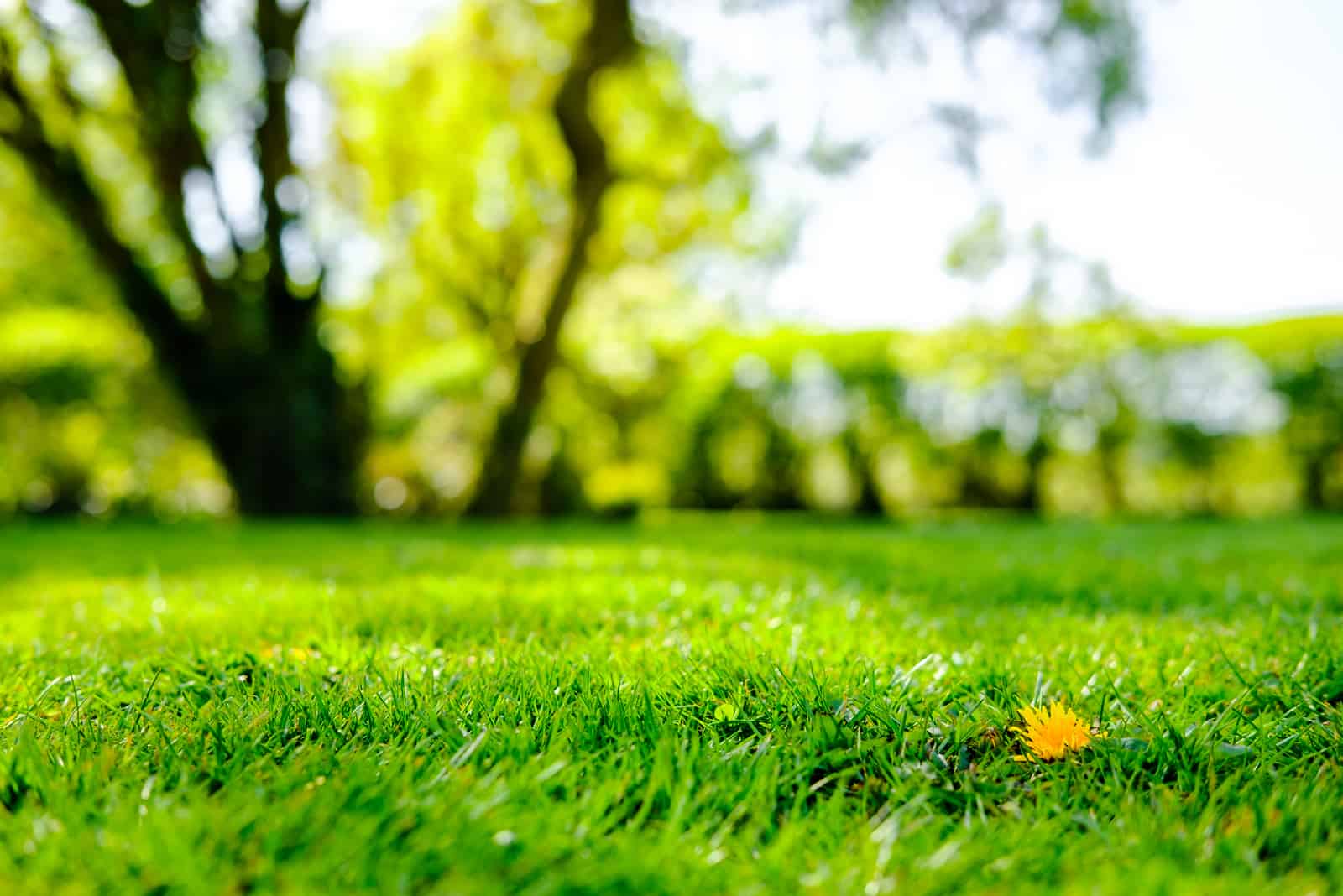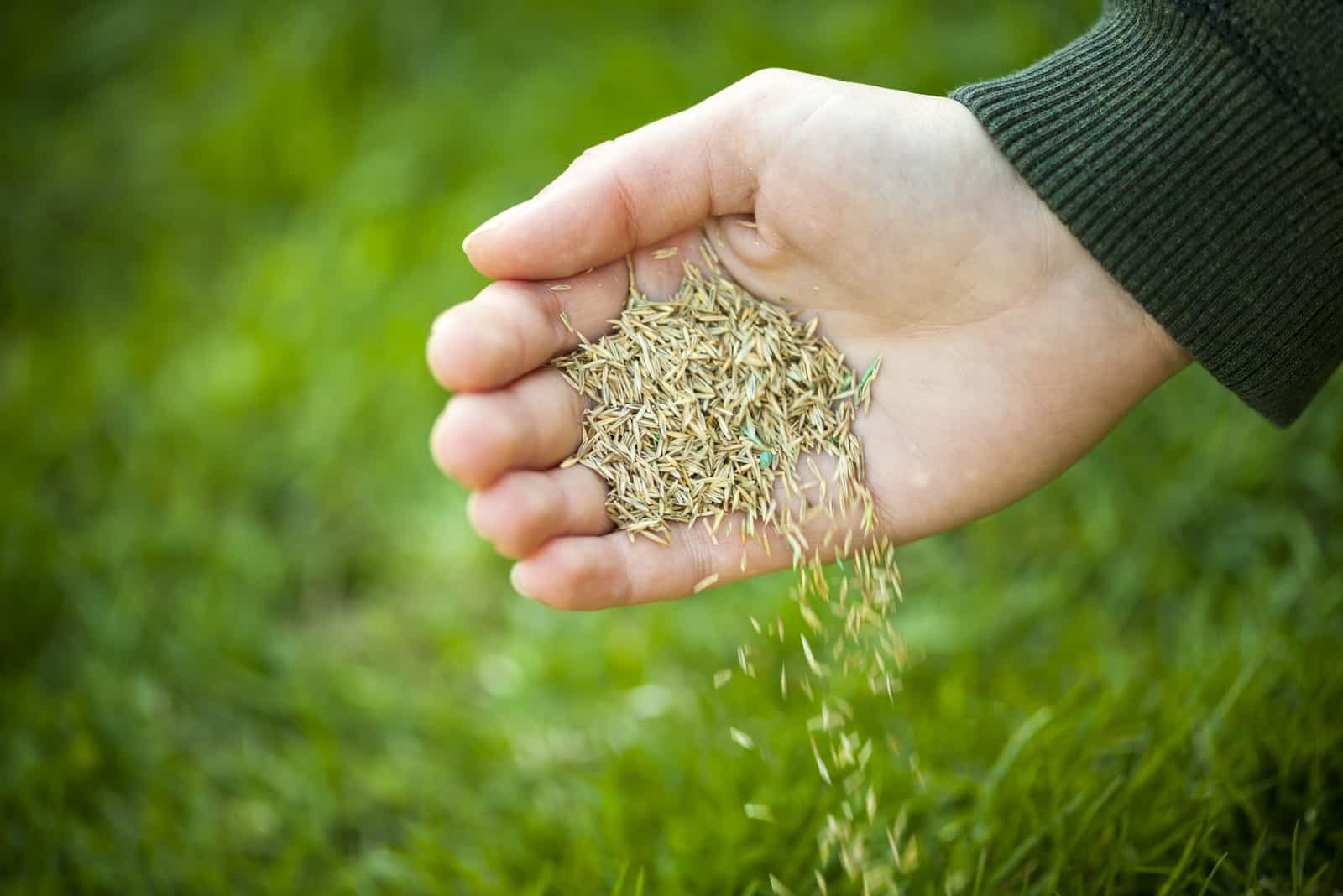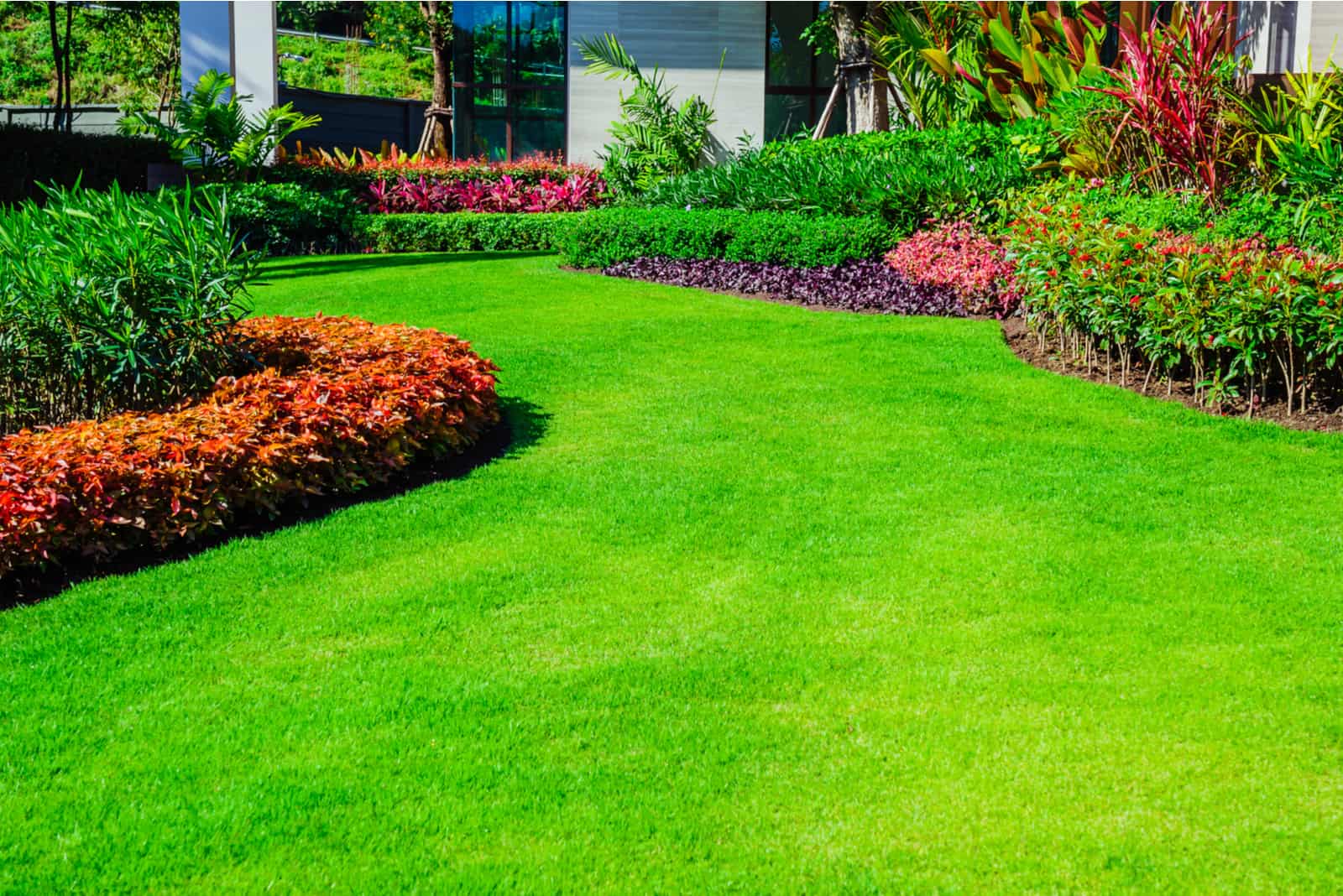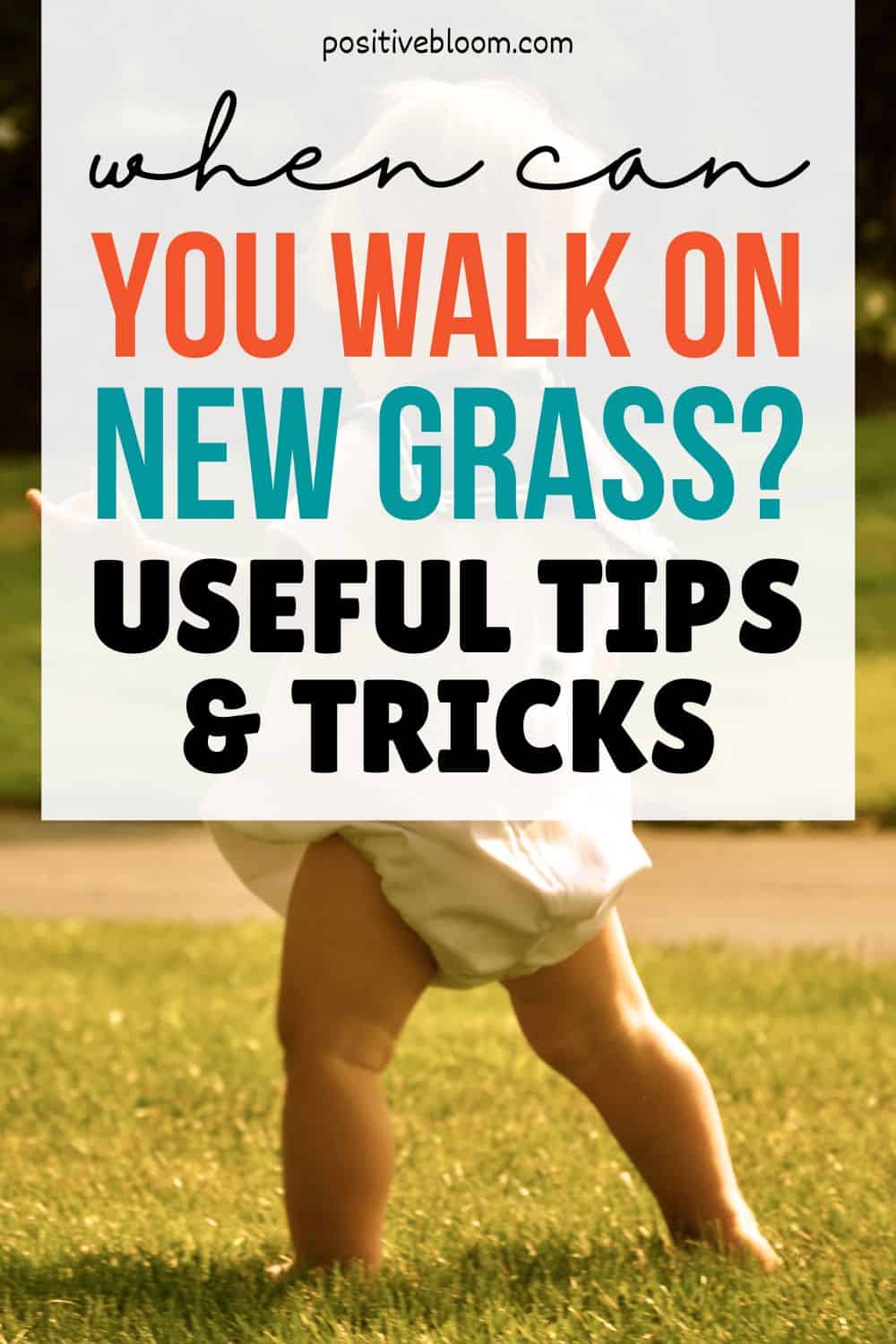If you have recently sown new grass seeds and the grass has grown a couple of inches, I’m sure your kids and pets are eager to run around on the new lawn while you enjoy a cup of coffee outside on a fresh summer morning.
But, when can you walk on new grass?
A freshly seeded lawn needs some time to establish, and walking on it can ruin those fragile little seeds. The general rule is that it takes about 2 months to have a fully established lawn after planting the seeds, but when is it safe to walk on it?
Stay tuned to find out the answer!
When Can You Walk On New Grass?
I always laughed at “no walking on the grass” signs when I was a kid, but now as a homeowner I take them pretty seriously!
Walking on an established lawn can make the soil more compact and destroy a freshly seeded lawn by preventing the seeds from germination and growing.
It usually takes several months for grass seeds to form a strong root system, and in most cases the lawn should be mowed a few times before walking on it for the first time.
Let’s look at the timeline:
• Planting grass seeds. The seeds have to germinate. You should not walk on the seeded area at this point.
• Grass sprouts start emerging from the soil. No walking yet!
• Grass has grown about 3 inches after 4 weeks. Time for mowing, but not walking!
• The grass has been mowed 3-5 times. Two months have passed. You can walk on your new lawn!
What To Do In The Meantime?
We already know that you shouldn’t walk on a freshly seeded lawn, but how can you keep pets away and what should you do about kids? It may also be hard to know when to mow.
We will answer all these questions now!
1. Keep Pets Away
In usual lawn care, you deal with both pets and pests. Pests are a more serious issue, but you must also find a way to minimize pet traffic.
If you are a pet owner, then you know that they can’t wait to get outside to run and play, especially on a sunny day. However, even though they don’t weigh as much as we do, they can still ruin grass seeds. In the beginning, your grass needs peace and proper care to grow and thrive.
Therefore, I would suggest you take your pets out on walks regularly instead of letting them run around on your lawn. You can even take them to playgrounds for animals. You can also put protection around the edges of your lawn if you have only seeded a small area of your backyard.
You can also create an alternative space for your pets to play in.
2. Don’t Let Your Kids Play On The New Lawn
This was probably the hardest step in maintaining my new lawn because my kids spend most of their time outside playing in the garden. If this is the case with you as well, then good luck keeping them inside!
What worked for me was going on walks with my kids and taking them to playgrounds and local parks. It’s really important to minimize foot traffic on a new lawn if you want to have the most beautiful lawn in the neighborhood!
3. Wait For The Grass To Grow Before Mowing
Mowing the lawn is an essential step in the lawn care guide, however, don’t start your lawn mower too soon after sowing the seeds!
If your new lawn is not ready for mowing then the mower blades will rip the little grass seedlings out of the soil, and the mower wheels can literally crush the young grass beneath them.
You should wait until your grass blades have grown about 3.5 inches tall. When you are mowing your fresh grass for the first time, you should not remove more than 1/3 of the grass height.
Cutting new grass too short is never a good option because it can damage the grass roots and also lead to thatch formation, which is a layer of organic matter that prevents air circulation and normal nutrient and water uptake.
Bear in mind that you should avoid cutting wet grass as it makes it more susceptible to pests and turfgrass diseases.
4. Mow The Lawn 3 To 5 Times Before Walking On It
It’s important to mow your new lawn at least three times before walking on it to promote healthy root growth. This way, you will harden your new grass and prepare it for foot and pet traffic.
There you go, that’s everything you need to know in order to have a beautiful and lush lawn perfect for playing and creating memories with your loved ones! <3
What Would Happen If You Walked On New Grass?
The little grass seeds are fragile, and putting any kind of pressure on them would easily damage them. Even if the grass has started to grow and sprout, these tiny grass seedlings have weak roots that can be ripped out of the ground by simply walking or running over them.
If there is any type of foot traffic on new grass, you will end up with a lawn that has bare spots all over it!
It’s also important to give the right amount of water to new grass seeds because you can easily overwater them, which would lead to similar effects as walking.
Tips For A Healthy Lawn
Taking care of a lawn is not an easy task, and you must pay close attention to several factors; from planting the seeds to maintaining an already established lawn.
Before planting, you should take into consideration the climate in your area so you can get an appropriate grass type. What type of soil you have and the sun exposure your lawn gets is also important.
Let’s start from the very beginning, which is choosing the right grass type.
Choosing The Right Grass Type
Even if you do every step of the lawn care guide correctly, from prepping the soil to watering the new grass seeds, if you didn’t pick the right grass type for your garden in the first place you will end up with no grass whatsoever!
You should always be aware of the climate in your area and the type of soil in your garden because they have a great impact on grass growth. Also be aware that if you have a shady garden, then you must plant a grass type that thrives in shade.
All grasses are grouped into two types: cool-season grasses and warm-season grasses.
Cool-season Grass Types
Cool-season grasses thrive in temperatures between 60 and 85 degrees Fahrenheit, however, they can tolerate much lower temperatures. The best time to plant these varieties is in the fall or early spring.
Cool-season grasses include:
• Ryegrass
• Creeping Red Fescue
• Bentgrass
• Fine Fescue
• Tall Fescue
• Kentucky Bluegrass
Warm-season Grass Types
The best time to plant warm-season grasses is in late spring or early summer. They will grow the best in warm temperatures over 75 degrees Fahrenheit. They can tolerate lower temperatures, but if it drops below 50 degrees Fahrenheit the fresh grass will start turning brown.
Warm-season grasses include:
• Zoysia
• Floratam St.Augustine
• Bahiagrass Argentine
• Centipede
• Bermuda grass
Preparing The Soil
You must provide the best soil conditions for your new grass seeds to germinate and grow. It is important that the soil is loose and not too compact so that the roots can grow easily, but also that there is enough nutrients to encourage growth and development.
In order for germination to occur, it’s important to keep the soil moist and the temperature warm. It usually takes about 2 weeks for seeds to germinate, but some grass types can take much longer. Check out what to do if your grass seeds don’t germinate right here.
Soil Types For Different Grasses
Common soil types in most gardens are clay, loam, silt, and sandy.
The best soil is probably silt, which is rich in nutrients and can retain moisture. As a result, it is suitable for a wide range of grass varieties.
Loam is a mix of all three types, making it ideal for growing lush, green lawns!
Clay soil is compact and deficient in nutrients, so seeds will have a difficult time establishing deeper roots. In clay soil, however, Zoysia, Kentucky Bluegrass, and Bermuda grass thrive. Centipede, Zoysia, and Bahia grass thrive in sandy soil, which is dry and has a lower pH.
Almost all grasses like a pH in the middle, ranging from 5.5 to 7. A pH of less than 7 indicates acidic soil, whereas a pH of more than 7 indicates alkaline soil.
Pro tip: Test your soil. You’ll be able to see the nutrients your soil is lacking, as well as the pH and moisture levels. It’s best to do this test before planting and fertilizing as your soil may be deficient in nitrogen while you’re using potassium-rich fertilizers, or your pH may not be appropriate for a certain grass type.
Tips and Tricks For Planting Grass Seeds
1. Invest in high-quality grass seeds, and avoid using seeds that have been improperly stored as some seeds can go bad and rot.
2. As we already mentioned, you should choose the right type because it is crucial for sustaining a healthy lawn.
3. Water the area before planting to make the soil softer and more comfortable for the new grass seeds.
4. Check the pH of the soil before planting the seeds as grass seedlings require neutral to slightly acidic soil. Provide good seed to soil contact by loosening the soil first.
5. Avoid planting the seeds too deep in the ground as this will prevent them from getting enough light and air to germinate and thrive. You can do it with a spreader or by hand.
6. Fertilize the soil before sowing grass seeds to ensure that they have enough nutrition.
7. Mulch can be used to hold seeds in place and minimize evaporation in newly planted areas.
8. Sprinklers should be installed. Even if you have to pay some money, the grass will appreciate it and you will save time and energy.
9. Herbicides and weed killers shouldn’t be used before or after planting because they can prevent germination.
Find The Perfect Watering Routine
There’s a difference between how you should water a freshly seeded lawn and an established lawn. You should water new grass seeds more frequently than adult grass. The ideal watering routine for new grass seeds would be to water them twice a day for 5 to 10 minutes.
The best time to water new grass is in the morning or the evening because the top inches of soil should always be moist.
Once the lawn is established, the watering session should be lower, but longer and more thorough.
You must water your lawn either before sunrise or very early in the morning. This is because your grass will require hydration throughout the day, especially if it’s in direct sunlight the entire time.
If you water it in the middle of the day, the water will quickly evaporate before it reaches the grass roots. You should also avoid watering at night because the humidity can be too high and attract pests and diseases.
Watering your lawn first thing in the morning is the ideal option, but getting up that early can be exhausting, which is why you should invest in a sprinkler that you can set at any time. Otherwise, you can also water the lawn in the late afternoon.
When watering, be sure to water thoroughly so that the entire lawn is moist. This takes roughly 45 minutes on average, although it can vary depending on the size of your lawn. Water at least twice a week to ensure that your lawn receives an inch of water per week.
If you live in a region with frequent rain, you should water your lawn less because Mother Nature keeps your lawn fresh and clean for you!
Mow The Lawn
Mowing the lawn correctly is probably one of the most crucial steps in lawn care. Different grass types have different growth rates, which is why it can be hard to tell how many times you should mow your lawn.
However, you can always check how tall your grass has grown. The ideal mowing height is 3.5 inches.
It’s best to cut grass in the morning because it might grow significantly overnight and it also needs time to heal until the evening.
Tips To Mow Your Lawn Correctly
• Make sure the lawn isn’t wet before you mow it. Cutting wet grass exposes it to fungi and turfgrass diseases, which can ruin your lawn.
• Don’t cut your lawn too short because it can cause stress. Longer grass blades can protect the topsoil and the seeds beneath them.
• You should remove any stones, sticks, and small objects that may damage your lawn mower.
• It is important to keep the blades sharp and clean. A sharp blade creates a cleaner cut, which makes your lawn look absolutely amazing. Clean the blade after every use.
• Don’t throw the grass clippings in the garbage. Instead keep them and use them as mulch.
• Be gentle and slow, especially if you are mowing your lawn for the first time. If you rush the whole process, you might rip the grass out of the ground and damage its roots.
• You should change the direction of mowing every once in a while to keep the grass growing straight. If you constantly mow the grass in the same pattern, it will get used to it and grow accordingly.
Fertilize Your Lawn
Fertilizing your lawn before planting, and also throughout the growing stages, can significantly improve your lawn — especially if you are dealing with soil low in nutrients.
You can use either liquid or granular fertilizer. Remember that liquid fertilizers should be used every other week, whilst granular fertilizers should be applied once a month.
I recommend using a slow-release fertilizer if you don’t have a lot of time to care for your lawn. This type of fertilizer only needs to be used once in the early spring and it will feed your grass all year long by gradually releasing nutrients.
The three most important nutrients are nitrogen, potassium, and phosphorus, and each lawn fertilizer should include either all three or at least one of them. The ratio is determined by the soil test results and the type of grass you’re growing.
Overseeding
Another excellent method for making your lawn appear thicker and greener is to overseed it. All you have to do is sow fresh seeds into an existing lawn to make it look thicker and more vibrant!
Keep in mind that the type of grass you use determines when you should seed. For example, if you have cool-season grass you should overseed your lawn in the fall or spring. In late April, though, warm-season grasses should be overseeded.
How To Overseed Your Lawn:
1. Cut your existing lawn to less than 2 inches in height.
2. Spread the seeds out using a spreader or by hand. Pay very close attention to areas that have thin grass.
3. Press the seeds down with the back of a rake. The seeds will be able to firmly attach themselves in the soil as a result.
4. Cover the seeds with a thin layer of compost.
5. Use a phosphorus-based starter fertilizer to aid in the development and growth of the roots.
6. After the grass has grown to about 3 inches tall, mow the lawn.
Control Weeds
Weeds are annoying, and there are a variety of treatments and herbicides that can be used to fight them.
As a precaution, many homeowners use pre-emergent weed killers before planting. Weed killers work by preventing weed seeds from developing, and if they are applied soon after planting they can have a similar impact on grass seeds.
You might end up preventing the grass seeds from growing and developing!
Weeds, on the other hand, can infiltrate your lawn and spread numerous turf diseases, making it appear thin and sloppy. Crabgrass, for example, is a common weed that can quickly spread over your lawn.
To get rid of these annoyances, you’ll need to use herbicides or weed killers. To avoid harming the grass seed and preventing it from germinating, while simultaneously stopping weed growth, I recommend waiting at least 10 weeks after sowing the grass seeds to use any weed killers.
Aeration & Dethatching
Aeration improves air circulation in the soil while also allowing for enhanced water and nutrient absorption. There are a few things you can do after aeration to make the most out of it!
For instance, the aeration process creates small holes in the lawn that are perfect for overseeding and also applying fertilizers that can reach the grass roots.
Dethatching is the process of eliminating the thatch from the soil that is preventing grass from absorbing essential nutrients. A covering of organic layers like grass clippings and leaves is referred to as “thatch.”
Frequently Asked Questions
1. Is it OK to walk on new sod?
No, it isn’t! Even though it might seem like they are already established, the grass roots are still pretty fragile and can be harmed easily. Therefore, you should avoid walking on new sod and also keep your pets away from it!
2. How long should you stay off newly planted grass?
You should wait for about two months before walking on a new lawn. Grass seeds germinate in the first two weeks and then continue sprouting and growing over the following two. Once the grass has grown 3.5 inches tall, you should mow the lawn.
However, walking should still be avoided. Once you have mowed the lawn 3 to 5 times, it is ready for foot traffic. Bear in mind that you should also keep pets away from newly planted grass as the seeds are delicate and fragile.
3. What can you do to help new grass grow?
Warm soil temperature and proper watering are crucial for the germination process. In fact, watering is probably the most important step as they need lots of water to keep them growing and developing.
You should also prepare the soil before planting by removing any debris, and also add fertilizer to improve the nutritional content of the soil. Don’t walk on your new grass. Water it lightly twice a day and your grass will be a lush lawn in no time!
Final Words
Now that you know when can you walk on new grass, it’s time to provide the best possible care for your lawn!
Bear in mind to keep kids and pets away from your freshly seeded lawn, and also to wait until the grass has grown at least 3.5 inches before mowing it for the first time.
Be patient and careful for the first two months, and then enjoy spending time on your established, lush, and vibrant lawn. You’ll be able to run, jump, roll, lay, and do whatever you want on it!
I hope this article was helpful 🙂
Until next time!
Like this post? Share or pin it for later!






